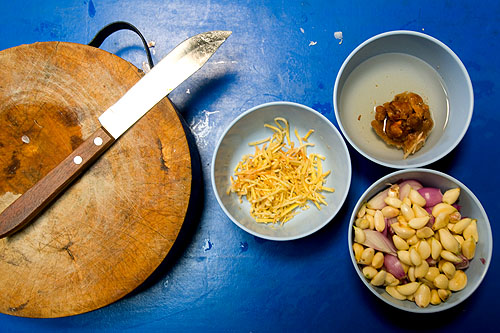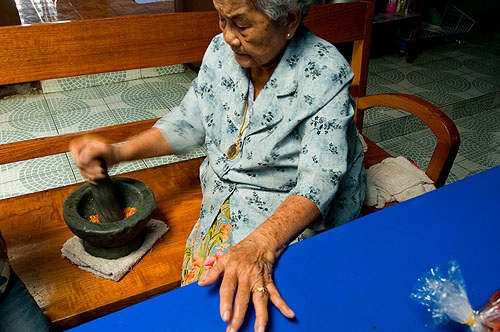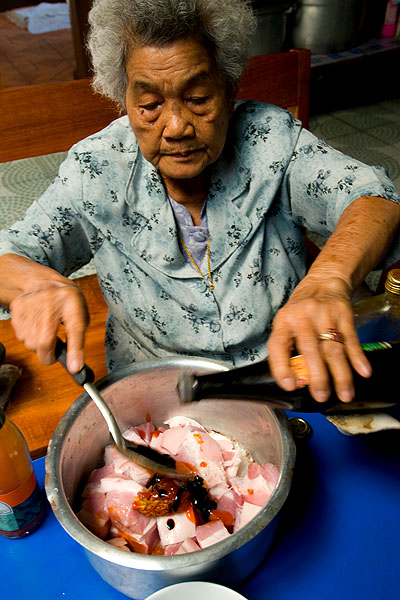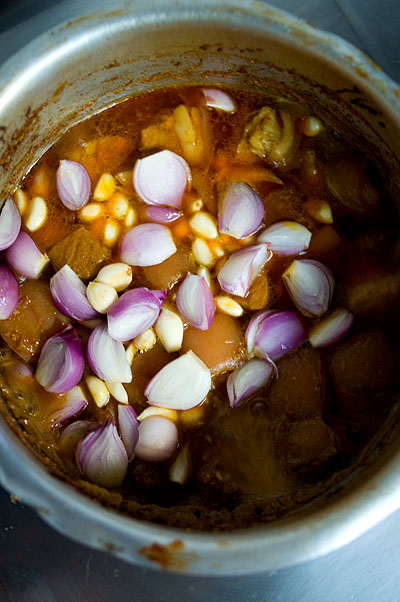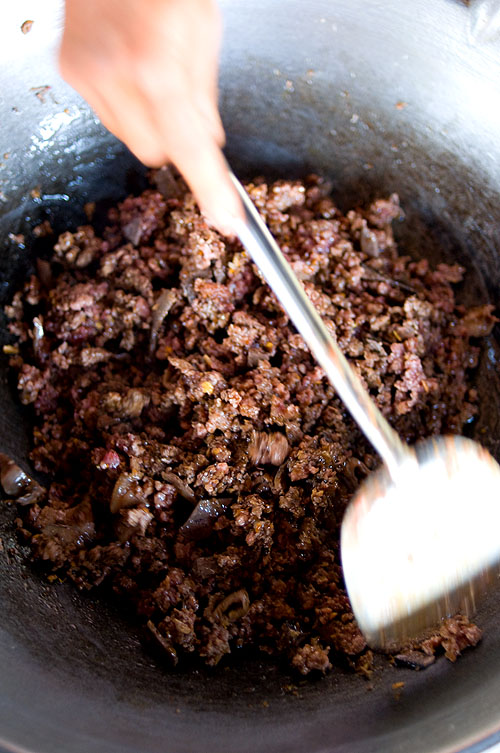 Fans of Thai food in the west are likely familiar with laap (or larb or laab), a minced meat ‘salad’ tart with lime juice and fragrant from the addition of khao khua, roasted and ground sticky rice. Fewer are likely familiar with the northern version of the dish of the same name, which contains neither khao khua nor lime juice, and instead gains its unique flavour from a mixture of dried spices specific to northern Thailand.
Fans of Thai food in the west are likely familiar with laap (or larb or laab), a minced meat ‘salad’ tart with lime juice and fragrant from the addition of khao khua, roasted and ground sticky rice. Fewer are likely familiar with the northern version of the dish of the same name, which contains neither khao khua nor lime juice, and instead gains its unique flavour from a mixture of dried spices specific to northern Thailand.
Laap mueang (mueang is a word used to describe anything northern) is one of my favourite Thai dishes. I've mentioned it a few times previously, but haven't really blogged about it in a general sense. So in this, the first of three blogs about the northern-style laap, I'm going to share general description of how it's made and the different varieties of it that exist. Because the spice mixture is such a crucial part of the dish, I'm hoping to follow this with a post about the delicious nam phrik laap (the spice mixture) made by a community group in Pha Bong, about 10km south of Mae Hong Son. And finally I'll follow that up with a recommendation for a decent laap restaurant here in Mae Hong Son.
If, after all this, you’re tempted to make laap khua, the northern-style ‘fried’ laap, I'd suggest combining the information provided in these blogs with this recipe provided the bloggers at EatingAsia, which appears to be a good approximation of the dish for those outside of northern Thailand without access to the more obscure ingredients.
I was able to watch Paa Add makes three types of laap while she was preparing food for her stall a couple days ago.
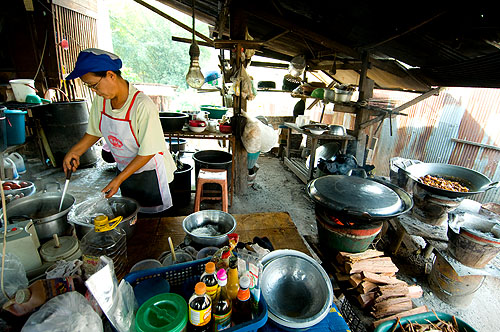
For all varieties of laap Paa Add begins with a variety of fresh pork and beef offal: liver, heart, tripe, intestine (both large and small), skin, fat and other unidentifiable (at least for me) bits. She boils them until tender and slices them thinly:
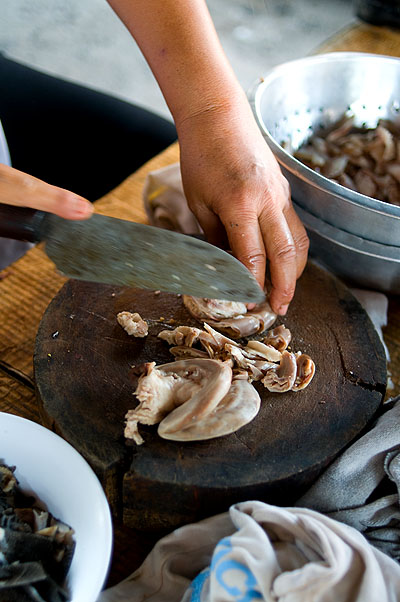
For the raw pork laap she takes a generous amount of fresh blood and liquefies it in a food processor. The impossibly red liquid is poured into a basin that already has some dried chili powder, salt, MSG, sugar and the laap spice mixture:
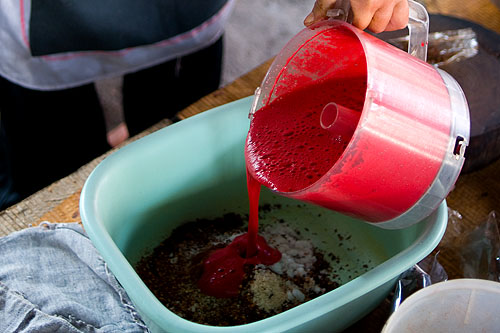
The ingredients are mixed with a spoon and raw minced pork is added. This is stirred again, checked for seasoning (after tasting the back of the spoon Paa Add added additional MSG, dried chili powder and some water), and the boiled pork offal is added. The laap is done at this point, and only requires a garnish of a mixture of minced coriander, sawtooth coriander (phak chee farang), green onions and mint, and of course, a fat basket of sticky rice to accompany it.
The process for making raw beef laap is nearly identical, except the ingredients, from the offal to the blood, are all beef-based, and a slightly bitter bile, known as phia, is added to the mixture:
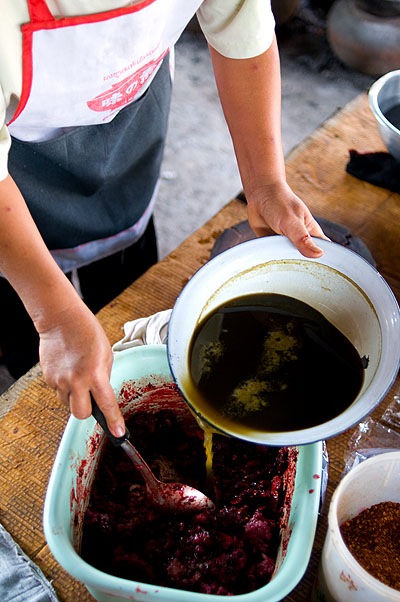
This type of laap is known in northern Thailand as laap khom, 'bitter' laap, because of the dominating flavour imparted by this ingredient.
The process to make make the more user-friendly laap khua, ‘fried’ pork laap, is initially at least, quite similar to the above. Paa Add combined some boiled pork offal, raw minced pork and a tiny amount of blood.
Into a large wok over hot coals she poured a very generous amount of cooking oil and added minced garlic, peels and all. She deep-fried the garlic until fragrant and ‘yellow’ in her words, before adding the pork mixture. This was followed by a generous amount of dried chili powder, MSG, salt, and the prepared laap spice mixture:
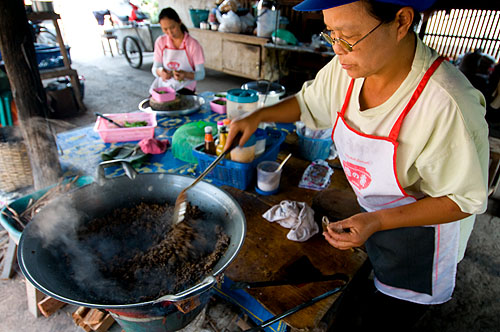
It took a good few minutes of cooking and stirring before the meat was thoroughly cooked and fragrant. She let me taste it at this point and the laap was intensely rich and spicy, and had the oily consistency associated with this version of the dish. Garnished and served with sticky rice and bitter herbs, it's among the most satisfying dishes in this part of the world.
 Hua Hin is an old-school seaside resort a couple hours south of Bangkok. It's still a popular destination today, particularly among middle-class Thais, but beer bars have begun made the centre of town feel more like Pattaya than a quaint fisherman's village. Nonetheless, if you walk along the beach you'll see several graceful holiday homes that echo the town's past, some of which have been refurbished as restaurants. Probably the most popular of these is Baan Itsara:
Hua Hin is an old-school seaside resort a couple hours south of Bangkok. It's still a popular destination today, particularly among middle-class Thais, but beer bars have begun made the centre of town feel more like Pattaya than a quaint fisherman's village. Nonetheless, if you walk along the beach you'll see several graceful holiday homes that echo the town's past, some of which have been refurbished as restaurants. Probably the most popular of these is Baan Itsara:
















 Perhaps I've lived here too long, or maybe I'm just jaded, but lately I've become convinced that there's little good Thai food in Bangkok. My cynicism seemed to be confirmed when a recent dining companion and longtime resident of Bangkok, Ung Ang Talay, expressed similar notions. He then proceeded to prove both of us wrong by taking me and buddy R to Dao Tai, a truly wonderful southern Thai restaurant in Thonburi (well, technically not Bangkok, but close enough).
Perhaps I've lived here too long, or maybe I'm just jaded, but lately I've become convinced that there's little good Thai food in Bangkok. My cynicism seemed to be confirmed when a recent dining companion and longtime resident of Bangkok, Ung Ang Talay, expressed similar notions. He then proceeded to prove both of us wrong by taking me and buddy R to Dao Tai, a truly wonderful southern Thai restaurant in Thonburi (well, technically not Bangkok, but close enough).


 While scooting around Ko Yao Noi I came across the scene above, a local woman stirring a vast wok of fragrant curry. I stopped and asked what was going on and she explained that she doing the Muslim equivalent of making merit by sacrificing an animal (in this case a buffalo) and sharing the meat with friends and family:
While scooting around Ko Yao Noi I came across the scene above, a local woman stirring a vast wok of fragrant curry. I stopped and asked what was going on and she explained that she doing the Muslim equivalent of making merit by sacrificing an animal (in this case a buffalo) and sharing the meat with friends and family:


 I love breakfast in southern Thailand. Unlike breakfast in the west (or even elsewhere in Thailand), which is typically as bland as possible, southern Thais fancy a bit of flavour in the morning. Khao yam, the rice 'salad' illustrated above, isn't exactly spicy, but the abundance of thinly-sliced fresh herbs certainly stands in contrast to a bowl of oatmeal or rice porridge. This dish was heavy on the galangal and mackerel, and served slightly warm, was a wonderful breakfast, particularly when coupled with a glass of sweet Muslim-style tea:
I love breakfast in southern Thailand. Unlike breakfast in the west (or even elsewhere in Thailand), which is typically as bland as possible, southern Thais fancy a bit of flavour in the morning. Khao yam, the rice 'salad' illustrated above, isn't exactly spicy, but the abundance of thinly-sliced fresh herbs certainly stands in contrast to a bowl of oatmeal or rice porridge. This dish was heavy on the galangal and mackerel, and served slightly warm, was a wonderful breakfast, particularly when coupled with a glass of sweet Muslim-style tea:
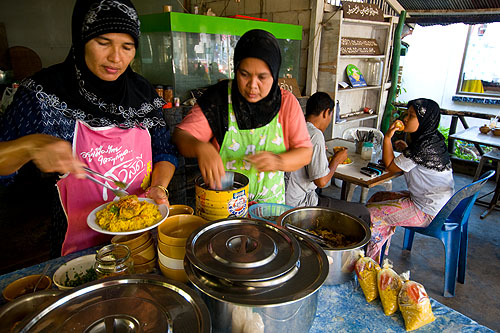



 or met ya ruang, or kayii or kayuu. Or met thai khrok or met hua khrok. Or perhaps even met mamuang himaphaan. These are all the different Thai dialect words for cashew nuts. The English word, cashew, is almost certainly a cognate of the Portuguese cajou, which apparently originates from the Tupi word acajú, and which is most likely also the source of kayuu, the term used on Phuket, the thought being that the Portuguese first introduced the fruit to Asia from its native Brazil.
or met ya ruang, or kayii or kayuu. Or met thai khrok or met hua khrok. Or perhaps even met mamuang himaphaan. These are all the different Thai dialect words for cashew nuts. The English word, cashew, is almost certainly a cognate of the Portuguese cajou, which apparently originates from the Tupi word acajú, and which is most likely also the source of kayuu, the term used on Phuket, the thought being that the Portuguese first introduced the fruit to Asia from its native Brazil.




 Undoubtedly my favourite dish I encountered in Bangladesh was phuchka (known elsewhere as
Undoubtedly my favourite dish I encountered in Bangladesh was phuchka (known elsewhere as 
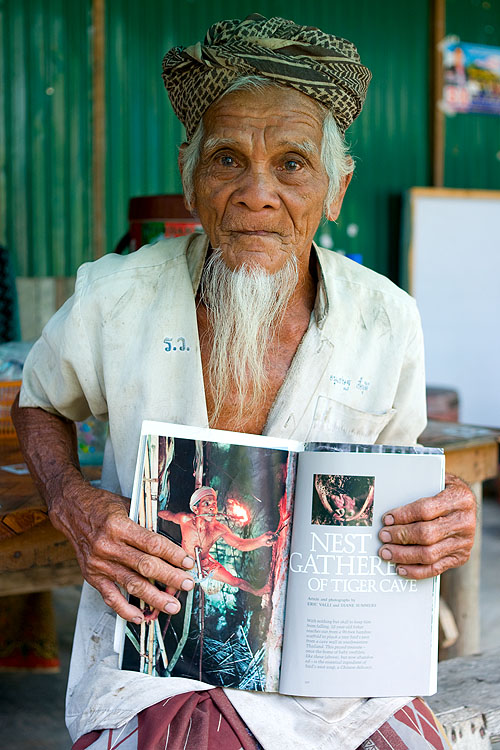
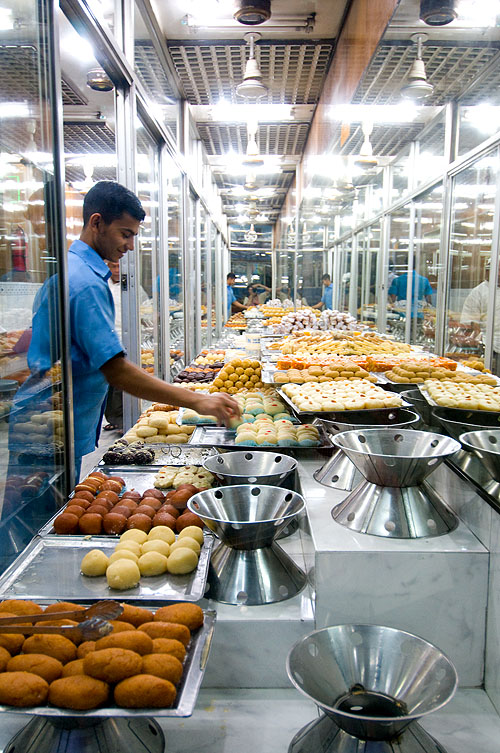 In general, food in Bangladesh wasn't much to write home about. There were a few interesting dishes, some of which I'll blog about soon, but most of our meals seemed to be endless but eerily similar variations on mutton and rice. The one area we were most impressed with was sweets. These ranged from syrupy-sweet golab jam, below:
In general, food in Bangladesh wasn't much to write home about. There were a few interesting dishes, some of which I'll blog about soon, but most of our meals seemed to be endless but eerily similar variations on mutton and rice. The one area we were most impressed with was sweets. These ranged from syrupy-sweet golab jam, below:




 I've spent the last several days traveling and taking photos in Bangladesh. It's dirty, noisy, crowded and the food isn't much to speak of. But the people here are by leaps and bounds the friendliest, kindest folks I've ever come across anywhere, and in a bizarre way, despite the garbage, pollution and poverty, Bangladesh is probably the most photogenic place I've ever been. Will be posting some more images here, including a bit of food-related stuff on
I've spent the last several days traveling and taking photos in Bangladesh. It's dirty, noisy, crowded and the food isn't much to speak of. But the people here are by leaps and bounds the friendliest, kindest folks I've ever come across anywhere, and in a bizarre way, despite the garbage, pollution and poverty, Bangladesh is probably the most photogenic place I've ever been. Will be posting some more images here, including a bit of food-related stuff on  get out of the hot spring. Or to put it in my context, leave Mae Hong Son. This was done with a great deal of reluctance, but it was beginning to get intolerably hot and smoky, a profound change from the first two weeks of my stay when I had to wear a fleece jumper and thick socks until lunch. One sign of the impending hot season is the floating restaurants that go up on the Mae Nam Pai:
get out of the hot spring. Or to put it in my context, leave Mae Hong Son. This was done with a great deal of reluctance, but it was beginning to get intolerably hot and smoky, a profound change from the first two weeks of my stay when I had to wear a fleece jumper and thick socks until lunch. One sign of the impending hot season is the floating restaurants that go up on the Mae Nam Pai: And now I'm back home in hot, sweltering Bangkok, although yet again in transition: tomorrow I'm off to Bangladesh (!) for a week and after that, will be in Phuket for a few days. An almost perverse contrast in destinations, for sure. Depending on the Internet situation in Bangladesh, I'll try to do some blogging, but can't make any promises.And lastly, I've entered a contest/marketing ploy for a prize to embark on my photographic 'Dream Assignment'. My dream assignment? Collaborating with a
And now I'm back home in hot, sweltering Bangkok, although yet again in transition: tomorrow I'm off to Bangladesh (!) for a week and after that, will be in Phuket for a few days. An almost perverse contrast in destinations, for sure. Depending on the Internet situation in Bangladesh, I'll try to do some blogging, but can't make any promises.And lastly, I've entered a contest/marketing ploy for a prize to embark on my photographic 'Dream Assignment'. My dream assignment? Collaborating with a  I was hoping to blog about a community group in Pha Bong, 10km outside Mae Hong Son, that gets together every weekend to make a spice mixture for laap, but when I drove out there on Saturday they weren't able to get enough lemongrass (they need a lot of lemongrass) and had rescheduled for the next day. Unfortunately I was leaving Mae Hong Son then and did not get a chance to witness this...
I was hoping to blog about a community group in Pha Bong, 10km outside Mae Hong Son, that gets together every weekend to make a spice mixture for laap, but when I drove out there on Saturday they weren't able to get enough lemongrass (they need a lot of lemongrass) and had rescheduled for the next day. Unfortunately I was leaving Mae Hong Son then and did not get a chance to witness this...
 Fans of Thai food in the west are likely familiar with laap (or larb or laab), a minced meat ‘salad’ tart with lime juice and fragrant from the addition of khao khua, roasted and ground sticky rice. Fewer are likely familiar with the northern version of the dish of the same name, which contains neither khao khua nor lime juice, and instead gains its unique flavour from a mixture of dried spices specific to northern Thailand.
Fans of Thai food in the west are likely familiar with laap (or larb or laab), a minced meat ‘salad’ tart with lime juice and fragrant from the addition of khao khua, roasted and ground sticky rice. Fewer are likely familiar with the northern version of the dish of the same name, which contains neither khao khua nor lime juice, and instead gains its unique flavour from a mixture of dried spices specific to northern Thailand.




 Paa Add cooks and sells a variety northern Thai and Shan dishes at Kaat Yaaw, Mae Hong Son’s evening market. She can be a bit of a hard sell, but is an extremely talented cook, her dishes both well executed and perfectly seasoned (her local-style fern shoot salad is a culinary masterpiece), even if you’re not familiar with the cuisine. I’d been buying her delicious curries, stir-fries and salads since coming here, when one day I asked her if she’d mind if I stopped by to see how they were made. She immediately dropped what she was doing and stared at me for at least five seconds. ‘Are you going to open a restaurant abroad?’ she asked.
Paa Add cooks and sells a variety northern Thai and Shan dishes at Kaat Yaaw, Mae Hong Son’s evening market. She can be a bit of a hard sell, but is an extremely talented cook, her dishes both well executed and perfectly seasoned (her local-style fern shoot salad is a culinary masterpiece), even if you’re not familiar with the cuisine. I’d been buying her delicious curries, stir-fries and salads since coming here, when one day I asked her if she’d mind if I stopped by to see how they were made. She immediately dropped what she was doing and stared at me for at least five seconds. ‘Are you going to open a restaurant abroad?’ she asked.




 This morning I took a drive along Hwy 1285, an isolated road that twists 15km between mountain valleys to the village of Huay Phueng, not far from the Burmese border. It's getting warmer in Mae Hong Son, but driving a motorcycle at 7am, in the shadows of the hills, it was so cold I quickly lost the feeling in my hands.
This morning I took a drive along Hwy 1285, an isolated road that twists 15km between mountain valleys to the village of Huay Phueng, not far from the Burmese border. It's getting warmer in Mae Hong Son, but driving a motorcycle at 7am, in the shadows of the hills, it was so cold I quickly lost the feeling in my hands.


 Jin lung are a local type of meatball, rich in fresh herbs and often yellow in colour from the addition of dried turmeric powder. They're most commonly made from pork, but beef and fish versions can be found on occasion. In Mae Hong Son's morning market they're sold in Indian-style pots in a generous amount of the yellow cooking oil, and when ordered, two or four (the serving sizes here are really small) are bagged up with a drizzle of the oil and some deep-fried crispy garlic.
Jin lung are a local type of meatball, rich in fresh herbs and often yellow in colour from the addition of dried turmeric powder. They're most commonly made from pork, but beef and fish versions can be found on occasion. In Mae Hong Son's morning market they're sold in Indian-style pots in a generous amount of the yellow cooking oil, and when ordered, two or four (the serving sizes here are really small) are bagged up with a drizzle of the oil and some deep-fried crispy garlic.



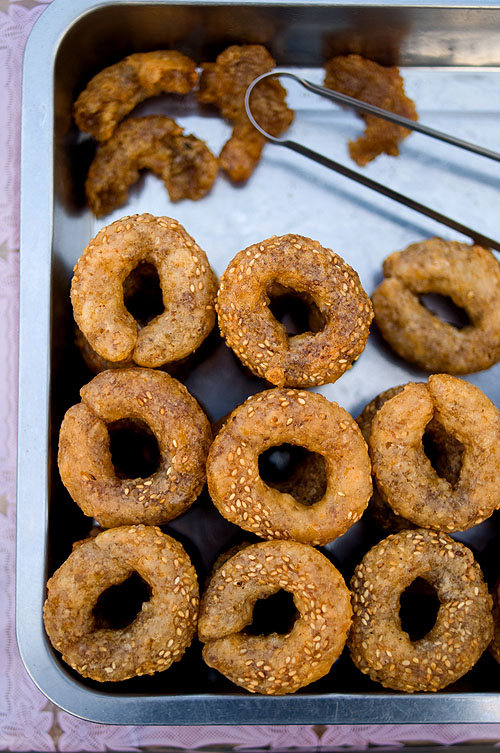 The bloggers at EatingAsia recently pointed out that
The bloggers at EatingAsia recently pointed out that 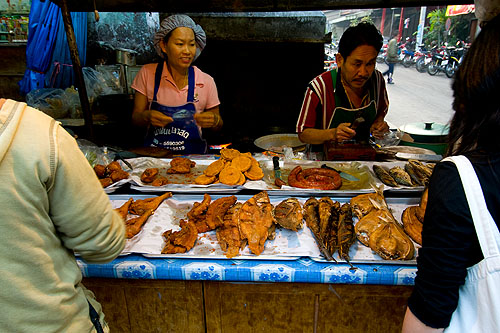
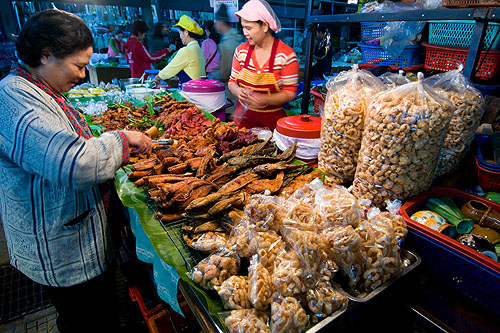
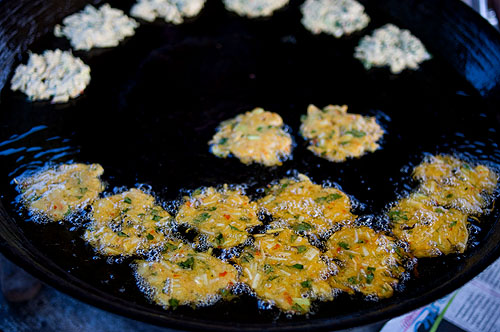
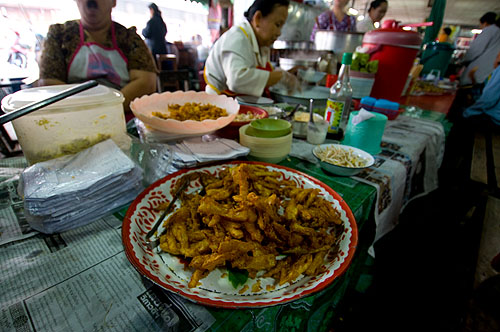
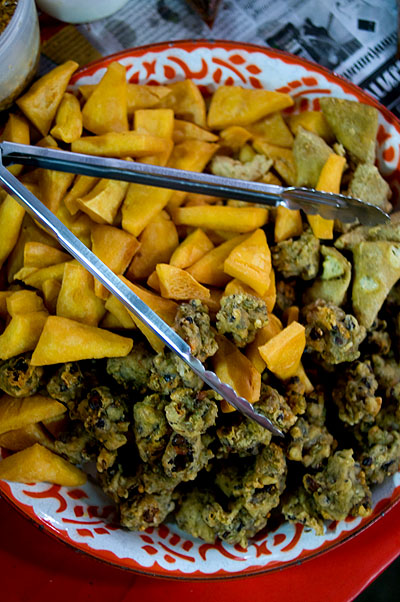
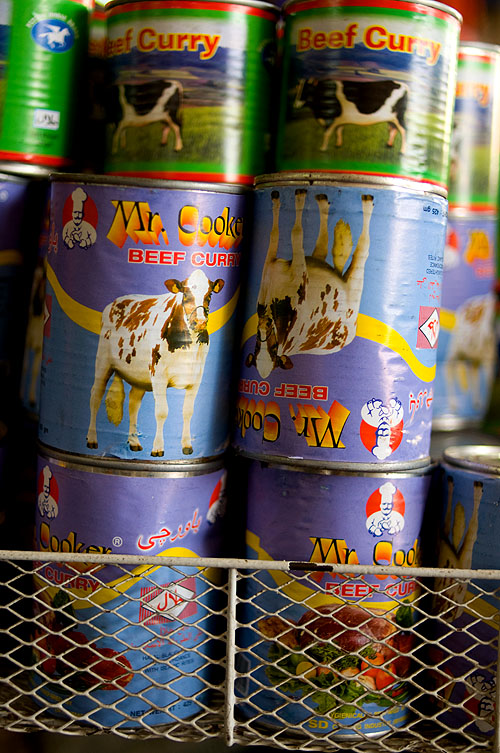 but I think I might have to draw the line at Mr Cooker brand tinned beef curry from Myanmar.
but I think I might have to draw the line at Mr Cooker brand tinned beef curry from Myanmar. A vendor of Burmese goods at the town's morning market
A vendor of Burmese goods at the town's morning market 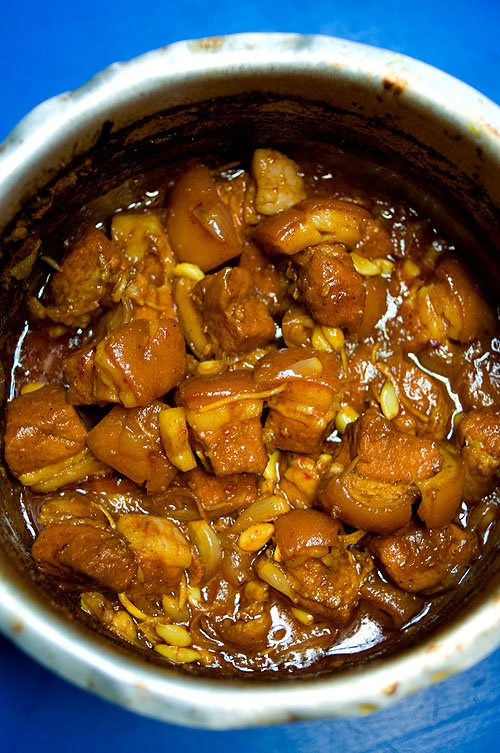 Khun Yay (‘Grandma’), my landlord’s mother, is originally from Ayuthaya, but moved to Mae Hong Son when she was 14 – more than 70 years ago. 'It took us three months to walk here from Ayuthaya,' she explained to me, adding that part of the journey was done on elephant back. After seven decades here she’s essentially a native of the city, and even used to earn extra money by selling Thai Yai/Shan sweets. She can also make the local savoury dishes, and everybody in the family agrees that she makes a mean hang lay.
Khun Yay (‘Grandma’), my landlord’s mother, is originally from Ayuthaya, but moved to Mae Hong Son when she was 14 – more than 70 years ago. 'It took us three months to walk here from Ayuthaya,' she explained to me, adding that part of the journey was done on elephant back. After seven decades here she’s essentially a native of the city, and even used to earn extra money by selling Thai Yai/Shan sweets. She can also make the local savoury dishes, and everybody in the family agrees that she makes a mean hang lay.